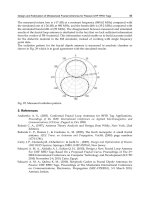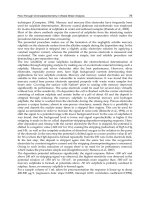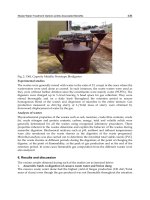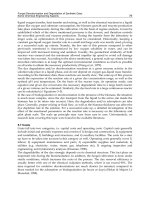Chapter 012. Pain: Pathophysiology and Management (Part 4) pot
Bạn đang xem bản rút gọn của tài liệu. Xem và tải ngay bản đầy đủ của tài liệu tại đây (48.93 KB, 5 trang )
Chapter 012. Pain:
Pathophysiology and Management
(Part 4)
Pain transmission and modulatory pathways.
A. Transmission system for nociceptive messages. Noxious stimuli activate
the sensitive peripheral ending of the primary afferent nociceptor by the process of
transduction. The message is then transmitted over the peripheral nerve to the
spinal cord, where it synapses with cells of origin of the major ascending pain
pathway, the spinothalamic tract. The message is relayed in the thalamus to the
anterior cingulate (C), frontal insular (F), and somatosensory cortex (SS). B. Pain-
modulation network. Inputs from frontal cortex and hypothalamus activate cells in
the midbrain that control spinal pain-transmission cells via cells in the medulla.
Pain Modulation
The pain produced by injuries of similar magnitude is remarkably variable
in different situations and in different individuals. For example, athletes have been
known to sustain serious fractures with only minor pain, and Beecher's classic
World War II survey revealed that many soldiers in battle were unbothered by
injuries that would have produced agonizing pain in civilian patients. Furthermore,
even the suggestion of relief can have a significant analgesic effect (placebo). On
the other hand, many patients find even minor injuries (such as venipuncture)
frightening and unbearable, and the expectation of pain has been demonstrated to
induce pain without a noxious stimulus.The powerful effect of expectation and
other psychological variables on the perceived intensity of pain implies the
existence of brain circuits that can modulate the activity of the pain-transmission
pathways. One of these circuits has links in the hypothalamus, midbrain, and
medulla, and it selectively controls spinal pain-transmission neurons through a
descending pathway (Fig. 12-4).
Human brain imaging studies have implicated this pain-modulating circuit
in the pain-relieving effect of attention, suggestion, and opioid analgesic
medications. Furthermore, each of the component structures of the pathway
contains opioid receptors and is sensitive to the direct application of opioid drugs.
In animals, lesions of the system reduce the analgesic effect of systemically
administered opioids such as morphine. Along with the opioid receptor, the
component nuclei of this pain-modulating circuit contain endogenous opioid
peptides such as the enkephalins and β-endorphin.The most reliable way to
activate this endogenous opioid-mediated modulating system is by prolonged pain
and/or fear. There is evidence that pain-relieving endogenous opioids are released
following surgical procedures and in patients given a placebo for pain relief.
Pain-modulating circuits can enhance as well as suppress pain. Both pain-
inhibiting and pain-facilitating neurons in the medulla project to and control spinal
pain-transmission neurons. Since pain-transmission neurons can be activated by
modulatory neurons, it is theoretically possible to generate a pain signal with no
peripheral noxious stimulus. In fact, human functional imaging studies have
demonstrated increased activity in this circuit during migraine headache. A central
circuit that facilitates pain could account for the finding that pain can be induced
by suggestion or enhanced by expectation, and it could provide a framework for
understanding how psychological factors can contribute to chronic pain.
Neuropathic Pain
Lesions of the peripheral or central nervous pathways for pain typically
result in a loss or impairment of pain sensation. Paradoxically, damage to or
dysfunction of these pathways can produce pain. For example, damage to
peripheral nerves, as occurs in diabetic neuropathy, or to primary afferents, as in
herpes zoster, can result in pain that is referred to the body region innervated by
the damaged nerves. Though rare, pain may also be produced by damage to the
central nervous system, particularly the spinothalamic pathway or thalamus. Such
neuropathic pains are often severe and are notoriously intractable to standard
treatments for pain.
Neuropathic pains typically have an unusual burning, tingling, or electric
shock–like quality and may be triggered by very light touch. These features are
rare in other types of pain. On examination, a sensory deficit is characteristically
present in the area of the patient's pain. Hyperpathia is also characteristic of
neuropathic pain; patients often complain that the very lightest moving stimuli
evoke exquisite pain (allodynia). In this regard it is of clinical interest that a
topical preparation of 5% lidocaine in patch form is effective for patients with
postherpetic neuralgia who have prominent allodynia.A variety of mechanisms
contribute to neuropathic pain. As with sensitized primary afferent nociceptors,
damaged primary afferents, including nociceptors, become highly sensitive to
mechanical stimulation and begin to generate impulses in the absence of
stimulation. There is evidence that this increased sensitivity and spontaneous
activity is due to an increased concentration of sodium channels. Damaged
primary afferents may also develop sensitivity to norepinephrine. Interestingly,
spinal cord pain-transmission neurons cut off from their normal input may also
become spontaneously active. Thus, both central and peripheral nervous system
hyperactivity contribute to neuropathic pain.









